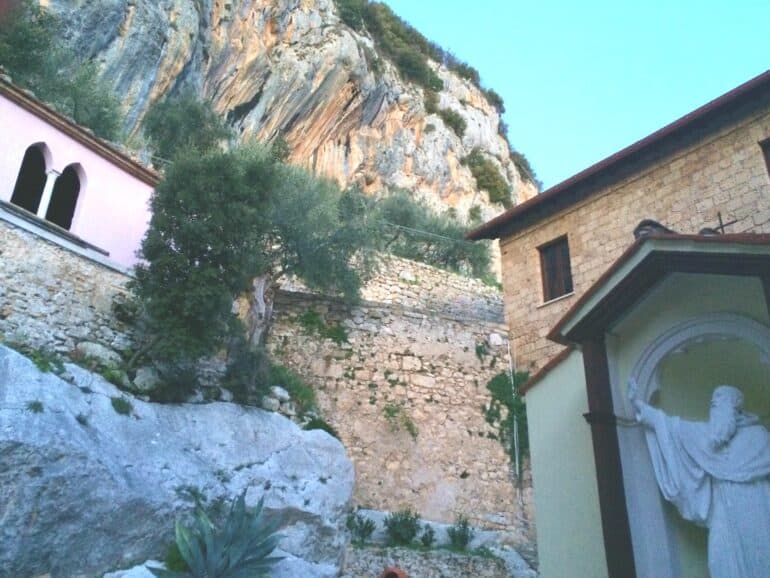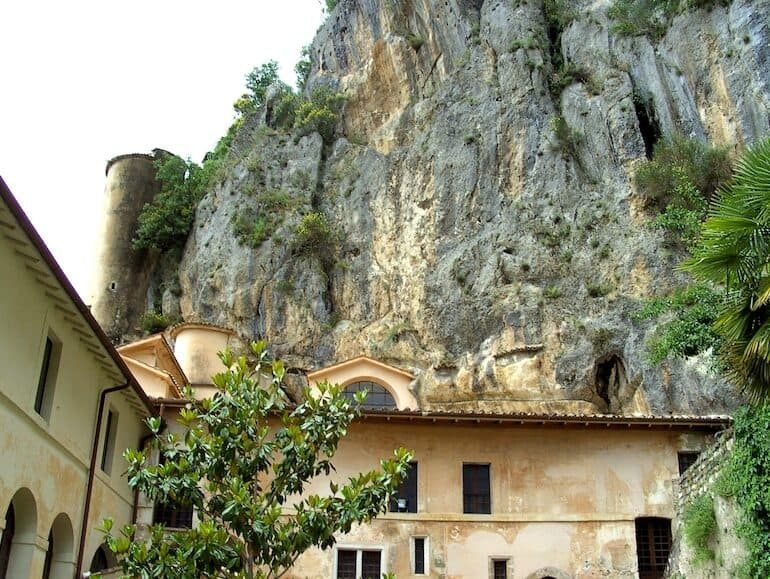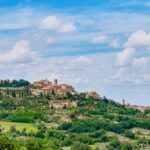A day trip from Rome immersed in nature and beautiful monasteries
Escape the city and plan a day trip from Rome to beautiful Subiaco – an oasis in the Lazio region where natural beauty, spirituality and Italian history meet. How to get there? A journey by motorbike with the wind whipping through your hair, perhaps? While there are more comfortable ways to arrive in Subiaco, it’s certainly the quickest. If you’re relying on public transport, getting to Subiaco may require an awkward combination of buses and trains, so by car is the best way to visit this very pleasant town in the region of Lazio. If you need to rent a car, check out this link.
An evening stop at the cave of St Benedict

Some 70 kilometres east of the city of Rome, the houses and spiritual sites of Subiaco are dotted amongst the forested hills. The town-planning here will be familiar to Romans, ex-pats and experienced visitors to Italy: the village gathers its narrow streets around piazzas, churches and bridges – the Aniene River is nearby.
Above the township, the hulk of the Rocca Abbaziale stands guard. A castle as well as an abbey, the “rocca” was built in the 11th century in to do just that – keep watch over the surrounding landscape.
It’s an area that could take up an entire day, visiting the Monastery of St Scholastica, dedicated to St Benedict’s sister, Scholastica, and founded in 520 (rebuilt many times since), as well as the medieval church of St Francis and the neo-classical churches of Sant’Andrea and Santa Maria della Valle.
But if you have only an hour or two to enjoy Subiaco, take a drive up the curving roads to the Monastery of San Benedetto to discover the sacred caves of St Benedict – it’s a place with its own tranquil magic
In the footsteps of St Benedict and St Francis

A little further out of town, the 13th century Monastery of San Benedetto is a striking complex of buildings that incorporates two churches with a number of chapels and caves. One is the Sacro Speco or holy cave of St Benedict, where he retreated in prayer in the 6th century.
Growing out of the rocky hilltop, the monastery was restored in 1893 but retains the square shape of its original Romanesque architecture. A darkened arched doorway marks the entrance to the Sacro Speco, the sanctuary of St Benedict – follow the beautiful loggia that frames the tree-clad hills alongside.
Two churches – one on top of the other

The upper church draws visitors deep into stillness – a stillness that’s populated with excellent frescoes from the early 14th century Sienese school, with others from the Umbrian-Marche school a century later. Crossing the Cosmatesque-tiled floor (in awe of the painted stories on every wall and on the ceiling above) you can also enter the fine courtyard, where a commanding statue of St Benedict ‘holds back’ the rocky mountainside.
Back inside, and descending by the sacred staircase to the lower church, you’ll find the cave where St Benedict withdrew for meditation and prayer. You may even be able to tag onto a tour given by a shaven-headed, black-robed Benedictine priest; pointing out the beautifully rendered curls of a figure in one of the frescoes, saying “I can only imagine what it would be like to have such wonderful hair.”
The face of Friar Francis

The Sacro Speco also claims the first-known portrait of St Francis of Assisi – that beloved barefoot saint and traveller who venerated poverty and is famous for his respect for the natural world, animals in particular. During the years 1223-1224, St Francis is said to have spent time in retreat in St Benedict’s cave.
Looking upon the worn – but restored – fresco of St Francis in the Chapel of San Gregorio, it doesn’t take any imagination to see the sense of brotherhood St Francis had toward all beings and the world around him.
The 13th century fresco is almost life-sized and was certainly painted before the saint’s death. It shows St Francis without halo or stigmata, the gentle lines of the lips and his soft yet direct gaze capturing the spirit of the man who, in the Canticle of the Creatures, described our sun and moon as “Brother Sun” and Sister Moon”.
A little blessing

If you take the priest’s tour, it’s the exit-through-the-gift-shop variety, where you can trawl through books and boxes of medals, rosary beads and crucifixes – you can also ask the priest to bless your purchases.
If there’s time, before you head back to Rome – or down the hill to Subiaco for dinner – take a stroll through the photogenic grounds, where the surrounding hills stand in deep green silhouette and the town of Subiaco spreads out below.




